Learning Outcomes
- After this course, participants will be able to describe the challenges of the use of consumer technologies for home control faced by people with disabilities.
- After this course, participants will be able to list several consumer products that can be used to control devices in the home environment.
- After this course, participants will be able to describe limitations to consumer technologies and instances where disability-specific solutions are appropriate.
What We Will Be Covering
- Electronic Aids to Daily Living (EADLs) provide an alternative means of controlling devices, primarily within the home environment, including audiovisual equipment, lighting, and thermostats.
- Advances in consumer home automation technologies have opened new control opportunities for people with disabilities.
This is an area that I have been teaching about my entire career. This came on my radar in my first year as an occupational therapist, but at that time, the technology that was available to us was very primitive. We have come such a long way since then. There is tremendous crossover now between this area of technology and consumer electronics, and that is what we are going to cover today. Please keep in mind this is rapidly changing, and a lot of the onus is still on us to make sure we are aware of the most available options.
What are EADLs? This is an area of assistive technology known as Electronic Aids to Daily Living and has been known by other names as well such as environmental control units. These provide an alternative means of controlling devices, usually at home like audiovisual equipment, the TV, cable box, music, lighting, thermostats, et cetera. Advances in consumer home automation have opened up control not only for the general population where we are controlling devices in a much different way, but it is also creating many opportunities for those with disabilities.
Different Technologies/Same Goals
- Many people with disabilities have difficulty controlling devices in the environment due to physical, visual, and/or cognitive limitations
- This control is important for independence, safety, and overall quality of life
- Early ECU systems became available in the 1980s
- The name later became EADLs
- This area of assistive technology was chronically underfunded and behind the level of consumer technology advancement
People who have disabilities have difficulty controlling things in the environment due to physical, visual, and cognitive limitations. For example, it might be difficult for someone to turn on their television and switch channels. They may not have the motor ability to reach out, grab the remote, and push a button. Or, they may not be able to see what is on the remote. They may not be able to remember a specific sequence of commands. For people with disabilities, this control becomes very important and it is not simply a convenience. Being able to control the environment increases a person's independence, safety, and overall quality of life.
Environmental Control Units (ECU) became available in about the 1980s. Consumer technologies were not very advanced during this time. In fact, this is when VCRs and CDs were just coming out. The name later changed to Electronic Aids to Daily Living (EADSs) to better define this area of technology and to improve funding. The challenge was, regardless of the name, that this area was chronically underfunded and constantly behind consumer technology advancement. It was also often overpriced.
- This technology fell into two main categories
- Basic EADLs
- Simple switch control of battery-operated and electrical devices
- SLATs, PowerLink
- Multi-Function EADLs
- Full control of a variety of devices and functions in the home
- Multiple access methods – direct, switch, voice
- Overlap with Home Automation and even Robotics over the years
- Now being replaced by Consumer Technologies, such as Alexa
- Basic EADLs
This area of assistive technology tends to fall into two main categories: Basic EADLs and multi Function EADLs. Basic EADLs are not used as much as they used to be due to advances in technology, but they still have a place for the clients we work with, particularly with children and with adults who have significant cognitive limitations. Basic EADLs provide simple switch control of battery-operated devices or simple electrical devices. For example, a stuffed cow that we see here in Figure 1 can be set up with a switch for a child to operate.

Figure 1. Switch operated toy.
Other examples are single on/off appliances like a light or a fan. This area of technology includes devices such as Switch Latch and Timers (SLAT--shown with the cow toy). This is made from AbleNet that allows switch control of a simple electrical device.
Then, we have multi-function EADLs and these provide full control of a variety of devices and functions within the home (Figure 2).

Figure 2. Multi-function EADL by Tash.
Instead of just operating one item, we now have control of an audiovisual system as an example. These devices allow you to not only turn the power on and off, but it also allows the changing of channels, the operation of the DVD player, and so on.
While there are still some of these devices out there, many are overpriced and often there is no funding. There are times when these are appropriate and we will review them. The other difference between multi-function EADLs versus our basic EADLs is that these devices can be accessed directly by pushing a button (if the client has the ability), by a switch, or by voice.
There has been an increasing overlap over the years between home automation devices and even robotics in the EADL realm and much of this technology is now being replaced by consumer technologies such as Alexa as seen in Figure 3.
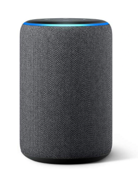
Figure 3. Alexa.
Electronic Aids to Daily Living
- EADLs provide alternative control of devices in the environment:
- Audiovisual equipment
- Electric hospital bed
- Nurse call
- Door openers
- Telephone
- Lights
- Appliances: fan
- Heating and air conditioning
Electronic aids to daily living provide alternative control devices in the environment. This can include an electric hospital bed, nurse call, door openers, telephones, lights, very simple appliances like a fan, and heating and air-conditioning systems. We now have the ability to control a more significant number of devices as well as functions for each of those devices. These systems typically use infrared. Infrared is what a typical television remote uses to send signals.
Multi-Function EADLS
- Provide control of a variety of devices and functions
- Typically use infrared and Insteon technologies
- Access:
- direct, switch or voice
- Usually too complex for young children or persons with cognitive impairments
A technology called Insteon can be used to control things that plug into the wall by using the wiring within your house. Insteon Technologies has, for the most part, replaced technology called X10. Some of these systems use other wired transmission options as well. One example is the PocketMate by SAJE Technology in Figure 4.
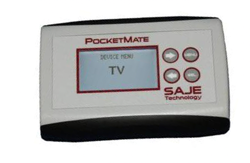
Figure 4. PocketMate by SAJE Technology.
Access, again, is by direct contact, switch, or by voice, and these systems are usually too complex for young children or people who have cognitive disabilities. Additionally, these systems often require good vision and good literacy which can be a limitation for some of our clients.
Basic EADLs
- Basic Electronic Aids to Daily Living provide alternative access to
- battery operated devices
- i.e. a toy
- simple electrical devices
- i.e. a fan
- battery operated devices
- or provide limited control of an infrared receiving device
- i.e. television “channel up” command
Basic EADLs are going to provide alternative access to simple devices such as those with a battery or those with a simple on/off control. For example, a simple device is plugged into the wall and there is a mechanical knob that turns it on and off. Some of the devices do not have a mechanical knob because they are digital, and they will not respond until it has power. These devices cannot be controlled by this type of technology. One example is television.
Then, there are a few basic EADLs that provide very limited control of something via infrared or IR signals. An example of that is this Relax from AbleNet.

Figure 5. AbleNet Relax.
It will send infrared signals to control something like your television, but the options are limited. It might include power, volume up, volume down, channel up, and channel down. These systems worked pretty well when we only had five channels to watch, but now we have hundreds. Channel up and down are not very helpful, and many of us now have remote controllers that let us push a button and talk to the remote. Now, I do not even have to remember what channel Food Network is, but rather I just have to say Food Network and it automatically goes to that channel.
Consumer Technologies
- Consumer Technologies now provide control of many devices in the environment using wireless networks and are controlled almost exclusively by voice.
- Intelligent Virtual Assistants can do more than control devices and features
- Provide information
- Provides entertainment
- Relatively low cost
- Ongoing advances and updates
- Two main categories
- Virtual Assistants
- Apps
Consumer electronics are quite advanced and now provide control of many devices in the environment. They rely on wireless networks. This means that someone like my mother-in-law who does not have the internet in her home cannot use Alexa. She could plug it in and the light will go on, but she is not going to be able to do anything. You have to have a wireless internet within your home, and most people in the United States do.
These consumer technologies are also controlled almost exclusively by voice so in order to access you need to have a clear voice. Most of these systems will support more than one person talking to them and recognize your voice readily right out of the box. This is opposed to assistive technology where voice recognition needs to be set up and trained to understand the client's voice.
Consumer technologies, such as Alexa and Google Home, shown in Figure 6, are called Intelligent Virtual Assistants.

Figure 6. Google Home.
Many of us are used to "Alexa," but there are other versions just like Kleenex is not the only facial tissue. Typically, we do not say, "Do you have facial tissue?" It is the same thing in this area of technology. The formal name for these is intelligent virtual assistants. They are capable of controlling specific devices like certain televisions, light sockets, outlets, special smart home thermostats, security cameras at our front door, et cetera. In addition, our clients can use an intelligent virtual assistant to get information and it can also provide entertainment. In my home, one of our most common questions to Alexa is: "What's the weather going to be like today?" Sometimes she is a little better at telling me what the weather is going to be than other times, but it is a great way of getting that information. I can ask for a news briefing, certain music, or a recipe. If the virtual assistant has a screen, I can ask to watch something from a YouTube video to a movie. There are many features for a relatively low cost. When you compare this to other EADL options, this really is a bargain. There are constant ongoing advances and updates, and since these are software-based, you do not have to buy the latest virtual assistant because it is going to update itself. This technology does change rapidly, however, and in a few years, you might want a new version.
There are two main categories to these intelligent virtual assistants: The virtual assistant themselves or the apps that we can run on our tablet or a smartphone. These can also control things within our environment, provide information, and provide entertainment.
The EADL Dilemma
- Consumer electronics provide inexpensive and fairly reliable home control solutions.
- However:
- These are not accessible to all of our clients
- These are not always reliable enough
- These may not control ALL required devices and features
- Some clients still cannot afford this technology
What is our dilemma? Consumer electronics are awesome as they provide inexpensive and pretty reliable home control solutions. However, once in a while, Alexa does not understand or answer me correctly. And, there are some challenges for the people that we work with. These are not accessible to all of our clients and we are going to go into more detail about each of these. First, these are not always reliable enough. If Alexa or one of these other assistants does not respond to me correctly, I might be frustrated, but my life does not depend on it. However, for some of our clients, they have critical commands and they need a reliable response. This technology may not control all required devices and features for an individual. Again, this is changing literally by the hour. And some clients, despite the low cost, may not be able to afford this technology. Let's go into a little more detail.
1. These Are Not Accessible to All of Our Clients
- Voice-based devices
- The client must have a clear and consistent voice
- These do respond well to synthesized voice commands
- Speech Generating Devices (SGDs)
- SGDs are usually funded
First, it is not accessible to all of our clients. There are a number of circumstances under which these may not be accessible. First and primary, these are voice-based devices. The client must have a clear and consistent voice in order for the virtual assistant to hear it and process and correctly respond. These systems do respond extremely well to synthesized voice commands. For example, I work with many nonverbal clients that use speech generating devices and these systems do typically respond well to them. The speech generating device is typically funded by the payer, while the family simply needs to purchase the virtual assistant, which again, is not nearly as costly as a communication device.
- Limited display options for visual feedback
- This is emerging now
- The client must remember commands
- Memory and sequencing
Another limitation with virtual assistants is that they have limited display options. Most of them do not have a display at all or may simply have some type of color-coding. For example, if the virtual system is blue, it is active. Conversely, if the light ring is red, there might be a problem, and if it is white, there might be a notification. Examples are shown in Figure 7.
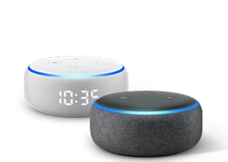
Figure 7. Echo Dot.
Virtual assistants may have a display like this Echo Show in Figure 8.
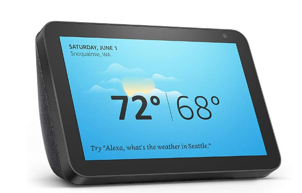
Figure 8. Echo Show.
This is emerging and this does provide visual feedback. For some of our clients, this can be very helpful. If there is no display or the display has limited capabilities, the client must remember commands. That requires some degree of memory and sequencing, and this can also be challenging for some of our clients. For example, if the client wants to adjust their thermostat, they need to remember what command to give their virtual assistant. There are ways that we can provide reminders for our clients or try to simplify the system for them.
Many older people are using virtual assistants. There is a wonderful commercial for Google Home that was shown during the 2020 Super Bowl. It showed an older gentleman talking to the Google Home and using it in a very unique way. The manufacturers of these technologies are very aware that we have an older population using this technology and they are anxious to make that easily usable for people who may not be as familiar with technology as someone who is say 15 years old.
- APPs
- The client must have good fine motor control or be able to use an alternative access method for a tablet or smartphone
- Switch access can be tedious as many APPs have large amounts of choices on a screen
In addition to the virtual assistant, there are apps that are available on phones and tablets. Like virtual assistants, these can provide control. However, unlike virtual assistants, these are primarily designed to be used with direct access. You reach out with your finger and you push something on this app. Thus, the client has to have good fine motor control or be able to use some type of alternative access method for the tablet or smartphone. This can be hard. Switch access, while available, can be a bit tedious as there might be a large number of choices on the screen to sort through. The client also has to have good vision to access these apps. The client has to visually scan through all these options to decide what they want to do. They need to also remember where the commands are within their app, and this requires some memory and sequencing. Figure 9 shows an example.
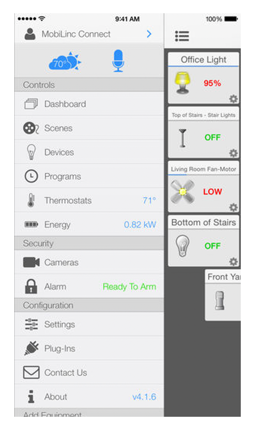
Figure 9. MobiLinc Connect App.
2. These Are Not Always Reliable Enough
- Voice operated systems may not always recognize a client’s voice
- If the Internet is down, the client will lose control
- Relies on Wireless Networks
- If the power goes out, the client will not have anything to control anyway…except the door opener to exit the home in an emergency
Consumer electronics are not always reliable. If something is not reliable, I might be frustrated, but it is not critical. I have been known to tell Alexa that she is not very smart at times. But on a serious note, voice operated systems may not always recognize a client's voice, even though their voice-recognition is very strong. If we are working with a client who is a bit difficult to understand and is not using a communication device, they may not be successful with some of these technologies. Also, if the internet is down or the power goes out, the client will lose control of their environment. Anything that is receiving power will not work, but it is very important that critical systems still work such as a door opener. This allows the client to get out of the home in an emergency. Even though it is possible to use a virtual assistant to control a power door opener, I usually recommend a separate controller for the door with a battery backup.
3. These May Not Control ALL Required Devices and Features
- These consumer based systems are not designed to control door openers, nurse calls or hospital bed controls
- Some creative people have managed to connect Alexa to a hospital bed, but this is not readily available … yet
- There are compatible third party door openers
- Changing rapidly
- These systems are also not generally allowed to be used in hospitals
- Interference with other equipment
- Privacy concerns - HIPPA
Virtual assistants may not control all the required devices and features. There might be some features that are better controlled by an EADL. For example, these consumer-based systems are not designed to control power door openers, nurse calls, or hospital bed controls as they are primarily designed for the general population. There are some creative people out there who have managed to get Alexa or other virtual assistants to work with a hospital bed, but it is not readily available yet. There are some compatible third-party door openers that will work with this technology. Again, and I cannot stress this enough, it is changing rapidly. By the time you listen to this, there might be a hospital bed out there that works with Alexa. As of today as far as I know, that is not the case. We always need to keep our finger on this pulse.
Another challenge is that these systems are not generally allowed to be used in hospitals. There are concerns that they can create interference with other equipment just like cell phones. Another big issue is privacy. Virtual assistants are always listening. Many people do not like them as they feel they are "listening" all the time. You may also have an opinion on that. For myself, I do not think I am talking about anything that is too terribly interesting. However, sharing personal health information in a hospital is a concern. There are ways around this. We can tell the virtual assistant to stop listening, or depending on the virtual assistant, push a button so that it is not listening for a while. On Alexa, there is a microphone button on top to turn off that function.
- Some APPs do not control all features of a device and the standard remote is still required for some commands
- This is changing rapidly!
Some apps, just like virtual assistants, do not control all the features of the device and a standard remote might still be required for some commands. Again, this is changing, but some of the early apps still have this issue. One example is apps for cable or satellite providers. They are assuming that you can use your remote for some functions. Additionally, as we talked about earlier, these apps also can be a bit challenging visually with a lot of information and may require literacy.
4. Some Clients Still Cannot Afford This Technology
- Even though prices continue to drop and features increase, this technology may be out of reach for some people
- A client must have wireless internet network in the home
- EADLs are not frequently paid for, but sometimes are
Despite these great prices on this technology, some consumers just simply may not be able to afford this, and they may not be able to afford to have a wireless network in their home. EADLs are not frequently paid for, but sometimes they are. I do not know of a payer that has agreed to pay for a virtual assistant but certainly not internet within the home.
- Most dedicated EADL systems are outdated and overpriced
- Less features, outdated features
- Manufacturers cannot keep up with consumer electronics, especially with poor funding
On the other hand, most of the EADL systems are significantly outdated and overpriced. In comparison to consumer electronics, they have fewer and outdated features. It is very difficult for these manufacturers to keep up with consumer electronics, especially considering that they rarely get paid.
Consumer Home Control Options
- Cloud based voice service, digital assistant, artificial intelligence
- There are many options
- These options are changing rapidly
- These options are not specifically designed for people with disabilities, but can be used by many
Now, we are going to talk about some consumer home control options. There are a lot of options out there which is great. These are cloud-based voice services, sometimes called the digital assistants or artificial intelligence, AI. Again, these options are changing rapidly and can be used by a lot of people. but they are not specifically designed for people with disabilities.
- Examples:
- Amazon Alexa
- Andriod Google Assistant
- Apple Siri
Some examples include Amazon's Alexa, Google Assistant, Apple Siri, and Android Google Assistant.
Amazon Alexa
- Alexa is an Intelligent Virtual Assistant powering Amazon’s Echo products
- Products are a Smart Home Hub
- Some include a Zigbee Hub to work with various smart devices
- Echo products include Echo speaker, miniature Echo Dot speaker, Echo Show (smart speaker with touch screen)
- Easy to set-up
- 100,000+ skills (third party capabilities)
- Smartphone apps used to set-up
- Apple and Android compatible
Alexa is extremely common. Alexa is an intelligent virtual system and behind all of Amazon's Echo products so you might hear "Echo" and "Alexa" used interchangeably. In a way, Alexa is the software and the Echo is the hardware. Amazon's products are called smart home hubs and use a wireless network. Many of these include a Zigbee Hub. Zigbee, like Insteon, is a transmission technique that uses the wiring within our home, and that is how it controls various smart devices that are plugged into an outlet or a socket like a light bulb or a thermostat. Earlier, Figure 7 showed an Echo Dot and Figure 8 showed an Echo Show. It has a display/touchscreen and a speaker. These are all pretty easy to set up and the list of skills is growing exponentially. At the time of this course, there are over 100,000 skills. These are third-party companies that work with Alexa to provide specific skills like Pandora. You use a smartphone app to set this up, and it is compatible with Apple and Android.
Google Assistant
- Intelligent Virtual Assistant powering Google products
- Home speaker and smartphones running Android include Assistant
- Google Home can be added
- Not as many smart home products available as Alexa
Google Assistant is something that a lot of people use as well. Again, it is an intelligent virtual assistant that powers Google products, such as Google Home (earlier shown in Figure 6). It includes a speaker, and there are Andriod smartphones that can do the same features via the assistant app. There are not as many smart home products available for the Google Home as there is for Alexa. I have heard from a number of people that Google Home seems to be a little smarter than Alexa in terms of performing a required request.
Apple Siri
- Included on iPhones, iPads, and Apple Watch
- Can add Apple HomeKit
- Not a lot of supported devices yet
We then have Apple Siri. This is included on iPhones, iPads, Apple Watch, and you can add something called the Apple Home Kit to provide further home automation capabilities. It does not have a lot of supported devices yet, but Siri actually replies and responds very well to both human speech and synthesized speech from communication devices. It can provide quite a bit of information and entertainment, and it is an easy way to practice some of these features.
Intelligent Virtual Assistant
- Virtual Assistants can do the following:
- Provide information
- i.e. tell you the latest weather and news
- Control Home Automation devices
- i.e. turn up the thermostat or dim the lights
- Playback media
- i.e. play music on Pandora
- And so much more!
- Provide information
Virtual assistants can do all of the above, and we have touched on some of this. They can provide information such as telling you the weather and news. They can control home automation devices that you buy that work with them such as a thermostat and lighting. They can also playback media like favorite music. These are very capable of pulling up all sorts of music services and much more.
- Virtual Assistants are controlled by:
- VOICE
- Strong voice recognition
- No training required
- Supports multiple users
- Some features can also be controlled by:
- Smartphone
- Tablet
- Touchscreen
- This technology responds very well to synthesized speech, allowing someone who is non-verbal or difficult to understand the option to use virtual assistants
- VOICE
Virtual assistants are controlled by voice. They do have very strong voice recognition. And I can't emphasize this enough: The early voice recognition systems that came out cost thousands of dollars and took extensive training to achieve a halfway decent voice recognition percentage. These do not require any training and support multiple users. So every member of your family can say, Alexa turn on that light and it will listen to this. Some of the features of that virtual assistant can also be controlled in addition to voice by smartphone, by tablet, or if available, by touchscreen on the virtual assistant itself.
How Do I Learn More?
- The Internet has many resources, instructional guides, and videos to guide you in the selection, set-up and use of these Consumer Technologies
- Remember, these change and improve daily!
Again, this technology responds very well to synthesized speech and that allows someone who is nonverbal or difficult to understand the option to use this technology. These change and improve literally on a daily basis. I happen to have an Alexa in my home. I receive emails on a weekly basis that say, "Here are all the new things you can ask Alexa." And, there is lots of support for that. There are also resources, instructional guides, and videos on the Internet that can guide your buying decisions and device setup. Definitely take advantage of those resources. There is a good chance you own a smartphone. My advice would be to try to use Siri once a day. Start practicing and before you know it, you will start using this more and more. I use Siri all the time and part of that is because I try to catch up with some work while I am driving and stay hands-free. Android phones have similar applications.
So, Do Clients Still Need EADLs?
- For now, sometimes
- Basic EADLs
- For young children with limited control needs
- For people with significant cognitive deficits
- Multi-function EADLs
- Rarely
Do we still need EADLs? We do need them occasionally but not as often as in the past. These include basic EADLs for switch toys, PowerLink, and simple appliances. These are still helpful for young children who have limited control and for people who have significant cognitive deficits who might struggle with a virtual assistant. Multiple function EADLs are used rarely, but there may be a few times where these are required. Let's review.
Basic EADLs
- Goals
- To provide independent play
- To develop cognitive skills through this play
- Psychosocial
- To prepare for future assistive technology use
- Access
- Is almost always by switch
Basic EADLs turn on a switch operated toy or simple device. The goal of using this technology is to provide independent play for perhaps a young child who cannot otherwise reach out, acquire, or manipulate objects. With this, we can offer alternative play for them. That play can help develop cognitive skills, prepare this client for future assistive technology use that's more sophisticated like a communication device. And psychosocially, this is very important as well, because this helps the child view themselves as a capable person, helps them participate within the family. Access is almost always by a switch.
How Does It Work?
- Direct connection
- Intermittent control
- Battery operated
- Electrical
- IR
We either have direct connection switch to a toy, or we use some form of intermittent control either for battery-operated devices, simple electrical, or infrared controlled devices.
Direct Connection
- Battery operated devices only
- Battery interrupter or pre-adapted
- Switch
- Requires sustained switch contact
- Good for preparing for power mobility
A direct connection only works with battery-operated devices. We take a switch, a battery interrupter, this one is from AbleNet in Figure 10, or we use a pre-adapted toy or device that has a switch jack on it.

Figure 10. Switch, battery interrupter, and toy.
If it does not, we plug the battery interrupter into it, plug the switch in and as long as the client maintains contact with this switch, that little pink pig is going to keep walking across the room. Sustained switch control is good for preparing someone to use power mobility because if this person is going to use a switch to drive, they need to hold the switch down to continue the movement of the chair and then release to stop.
Intermittent Control
- Latch
- Timed seconds
- Timed minutes
- Requires intermittent switch activation
- Good for developing scanning skills
We then have intermittent control, and this requires something called a Switch Latch and Timer in Figure 11.
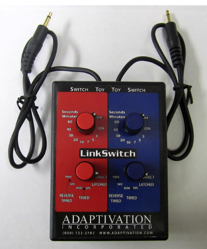
Figure 11. Switch Latch and Timer.
In Latch mode, the first activation of the switch will turn the device on, and it will keep going until the batteries wear out or until the switch is pressed a second time and that turns it off. This is just like a light switch. The first switch activation turns it on, and the second switch activation turns it off. We can also use this in a timed mode where you can set the Switch Latch and Timer for a certain amount of seconds (1 to 60) or minutes (1 to 60). Depending on what you are turning on, you can choose a certain amount of time. For example, you can plug in a battery-operated fan, and the client activates that switch and it stays on for a prescribed amount of time and then turns off. The client then needs to turn it on again with another switch activation.
- Good for developing scanning skills
- Anticipation
- Waiting
- Accurate activation
- Timing
This is great for developing scanning skills as the client is going to anticipate that this device is going to turn off or the toy is almost done running. They have to wait, reach out, and accurately activate the switch. This also starts to develop timing. All important skills for developing scanning skills. Again, these skills are used in more advanced, sophisticated technologies.
Intermittent Control-Battery Devices
- AbleNet Big Beamer and Jelly Beamer
- 1-60 seconds
- 1-60 minutes
- Latch
- Direct
- Great for moving toys
Here are some examples, AbleNet had something called their Big Beamer and their smaller Jelly Beamer (Figure 12).
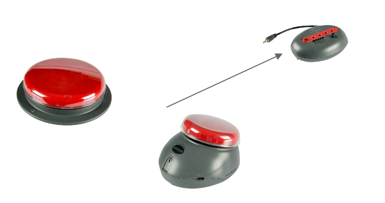
Figure 12. Big Beamer and Jelly Beamer by AbleNet.
When the client activates one of these switches, it sends a signal to a wireless receiver. This works really great for toys that are moving around, like a toy car, because you can just attach it to that toy and you can use this in latch or in timed mode. It also works in a direct mode. Now, it is not directly connected to this toy in this case, but it can require sustained switch contact in direct mode.
- AbleNet Mini Beamer Transmitter and Receiver
- Wireless
- Proximity sensor
- Auditory and visual feedback
- Rechargeable
- 1-60 seconds
- 1-60 minutes
- Latch
- Direct
AbleNet also has a Mini Beamer transmitter and receiver shown in Figure 13.
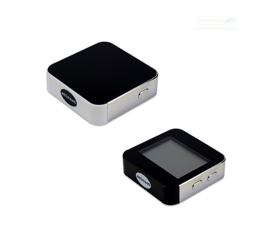
Figure 13. Mini Beamer transmitter and receiver by AbleNet.
The top of this switch is actually a proximity sensor so no force is required. If a different switch works better for the client, you can plug it into a switch jack on the side. It does provide some auditory and visual feedback in addition to the activated device. For example, when this surface is activated, there is a slight beep and a visual display here cueing the client that they have successfully activated the switch. These are rechargeable and that is cool because the other Switch Latch timers out there require batteries. This you just plug in a little mini USB, similar to your smartphone, and you can use it over and over again in timed, latched, or direct modes.
Intermittent Control of Electrical Devices
- Same advantages of Battery Operated Devices
- And more…
- No batteries!
- Increased variety of devices
- May be more appropriate for teens and adults
We can also provide intermittent control of simple electrical devices. but we do not have to put batteries in that little battery-operated toy.
- Will only work if the electrical device turns on and off when plugged in or out of an outlet
- Not electrical switches
- i.e. fan vs. CD Player
It provides an increased variety of devices. And, older devices will work with these basic EADLs. Here are some examples of other devices that are often used with basic EADLs.
- blenders
- food processors
- fans
- coffee pot
- paper shredder
- lamp
- Waterpik®
- wave machine
- lighted mirror
- heating pad
- heating pad/vibrating
- stereos (mechanical buttons)
- hairdryer
- foot massagers (water)
- popcorn makers
There are many devices that might be engaging for a client. This technology helps the client develop switch skills for future technologies, and it allows some simple control for children or adults who has cognitive limitations. If you have other ideas, shoot me an email as I would love to hear. One of my clients' favorites is a lighted mirror. Other clients love cooking and having control over a blender makes them very happy.
- AbleNet PowerLink4
- Six modes of control
- Direct
- Latch
- Timed Seconds
- Timed Minutes
- Two Switch
- both switches must be held to activate
- Count
- data collection
- Controls two appliances
- independent of each other
To provide this intermittent control of a simple electrical device, our only option on the market right now is from AbleNet, it's the PowerLink 4 (Figure 14).
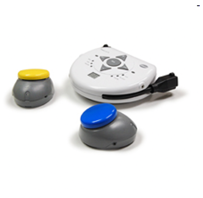
Figure 14. PowerLink 4 by AbleNet.
It has many modes of control. There is a unique option where both switches have to be held down to activate. There might be two switches that are connected to this PowerLink. You could use that to work on two-handed control. You can also use that to get two students to work together and that can be fun as well. It does keep track of how often the client is hitting a switch. This can be used to collect some data for IEP goals as an example. It can also control more than one device. One switch can control one device, like a fan, and another can control a second device, like a blender.
Case Study
Here is a case study of a client who used both of these technologies, both EADLs and consumer electronics.
- Mackenzie
- Age 4
- Cerebral palsy
- No independent play
- Non-ambulatory
- Non-verbal
McKenzie at the time of this evaluation was four years old (Figure 15).

Figure 15. McKenzie.
McKenzie has cerebral palsy and did not have any ability to play on her own. She was not able to reach out, acquire, or manipulate toys, and this is a very important part of childhood. She was also nonambulatory and nonverbal.
- Began with determining a switch type and location
- Next, a simple switch toy
- Providing play
- Providing independence
- Developing switch skills
We began by determining if she was able to use a switch. She was able to pull back with her elbow and activate an AbleNet Jellybean switch behind her arm consistently.

Figure 16. Switch placement behind her elbow.
We then had her operate a simple switch toy. She could push the switch and the toy would move to allow her to play and begin seeing herself as a capable person. It also helped her to develop switch skills for future assistive technologies including a power wheelchair and a communication device.
- Increased variety of switch toys
- Important for motivation
- Added a SLAT to develop motor and cognitive skills, as well as to develop scanning skills in preparation for a speech-generating device
Over time, we increased the variety of switch toys to maintain interest and motivation. We then added a Switch Latch and Timer to further develop her motor and cognitive skills. Now, instead of only holding down the switch to make the toy go, she could hit the switch once, the toy would activate for a set amount of time, and then she had to hit the switch again. This again helped her to develop scanning and timing skills in preparation for controlling a speech-generating device.
- Added an AbleNet PowerLink to allow control of electrical devices
- Expanding control opportunities
- Christmas tree lights
We then added a PowerLink to the mix. This expanded her control over electrical devices. As it was around the holiday, she could use a switch to turn on Christmas tree lights. She would turn them on each afternoon, and then before bed, she would go over and turn them off using the latch mode.
- As Mackenzie grew older, she received an SGD and began to use this to control an Alexa unit
- She enjoys asking Alexa to tell jokes, play music and read her stories
- She is not interested in controlling lights or the thermostat, at this time
As Mackenzie got older, she did receive a speech-generating device, and she was able to control that with the switch. She did not have the ability to use eye gaze due to a cortical visual impairment; however, she could use auditory scanning where she used a single switch and listen to her choices. With this, she gained competence and increased her vocabulary in order to use Alexa for other things like to tell her jokes, play music like Taylor Swift, and even to read her stories. This is the beauty of these consumer electronics. We are not limited to basic control, and it is both motivating or meaningful for an individual.
- Provide control of a variety of devices and functions
- Typically use infrared and Insteon technologies
- How can the client access the EADL?
- Direct
- Switch
- Voice
- Many SGDs and PWCs are capable of sending IR signals
- Should be more reliable than Consumer Technologies, but not always
There are a few circumstances where multi-function EADLS may still be required, even in this world of growing advancing consumer technologies. They provide control over a much greater variety of devices and functions than basic EADLs. Typically, these use infrared and Insteon technologies. It is important to note that some infrared technologies are going away as they are getting outdated. These can be controlled directly, by a switch, or by voice. Many of our speech generating devices and complex rehab power wheelchairs are capable of sending infrared signals. Unfortunately, they are quickly becoming more outdated as well. These should be more reliable in consumer technologies, but not always are, particularly infrared, and that is why it is going away. Where is this technology critical?
- It is critical to ensure the client can make a phone call and exit the home in an emergency, even if the power is out
- Specialty function EADLs
- Smartphones
- Door openers with back-up access (i.e. switch) and power (battery)
It is critical to make sure that clients can make a phone call and exit the home in an emergency, even if the power is out if it is within their capabilities. Phones are not as big a deal anymore in terms of power. However, if there is a fire, the client needs to be able to exit the home. This requires an accessible door (as shown in Figure 17). Additionally, a door opener needs some type of battery backup access.

Figure 17. Norton door opener.
The ability to make a phone call or exit the home may be critical if a caregiver does not show up or there is some other type of medical emergency, There are some specialty function EADLs like an adaptive phone or a way for a client to reliably use a smartphone. That might be by voice or by other technologies.
Great Resource
- Stratus ECS
- Environmental Controls as a Service
- From Broadened Horizons
- StratusECS.com
- Uses Consumer Technology and wireless networks
- They develop a custom solution for a person with disabilities
- Often funded
- Frequent upgrades to keep up with consumer technologies
There is a newer resource that I found just recently that I think is amazing called Stratus ECS. ECS stands for Environmental Controls as a Service. Environmental controls are a more outdated term, but it does refer to this area of EADLs. This is a service that is provided by Broadened Horizons. Broadened Horizons has made EADLs for a little while now, but they are trying to also recognize the fact that people are starting to use consumer electronics more and more. You can find the service at StratusECS.com. They use a combination of consumer technologies and wireless networks and will help your client to develop a custom solution for personalized disabilities. As such, they are often funded. They are also able to provide upgrades to keep up with consumer technologies. They do the majority of their work remotely so you do not have to worry about them being in your area.
Take-Home Message
- Many clients lack independent control of devices within their environment
- Basic control is a safety issue, particularly phone and door
- Independent control is an important therapy goal
Many clients require independent control of devices within their environment. We know that basic control, particularly for a phone or a door, is needed for safety. Independent control is an important therapy goal. It is a part of what we offer our clients. I want to thank you very much for joining us on this important topic. I hope it is helpful to you and provides some valuable updates to our more antiquated options in this area of assistive technology. I want to direct your attention to many of my other webinars on OccupationalTherapy.com as well. Many of them on other assistive technology topics so I would encourage you to check out.
Citation
Lange, M. (2020). A new era: From EADLs to Alexa!. OccupationalTherapy.com, Article 5193. Retrieved from http://OccupationalTherapy.com
